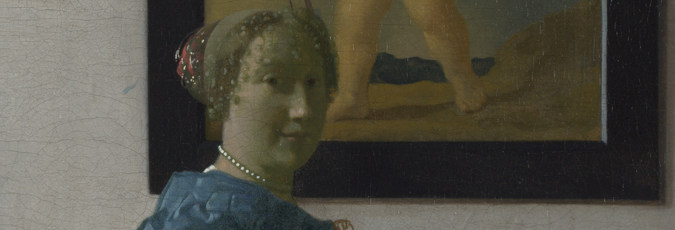Vermeer was a master of colouristic effects, but like most 17th-century Dutch painters he worked with a surprisingly limited palette. In these four paintings Vermeer used ultramarine – by far the most expensive pigment available to artists – to the exclusion of all other blue pigments. The only green is green earth, although a range of red pigments was employed: vermilion; red lake and red earth. Yellows identified are lead-tin yellow, yellow earth and a yellow lake pigment. The palette also includes bone black, charcoal black and lead white.
Pigments reported in other paintings by Vermeer include: azurite, smalt, indigo, an iron phosphate pigment likely to be vivianite; the copper green pigment verdigris; as well as greens made from combining blue and yellow pigments; and lake pigments likely to be weld (yellow), cochineal and madder (red).1
Ultramarine
An expensive mineral blue pigment extracted from the semi-precious stone lapis lazuli, which was imported into Europe via Venice from Afghanistan.
Ultramarine – extracted from finely ground lapis lazuli – was extremely expensive. Most artists used it sparingly, hoping to derive maximum effect from its distinctive intense blue colour. By contrast, Vermeer made liberal, almost unorthodox, use of this costly pigment, mixing it into a range of colours. Apart from unifying the overall colouristic effect, its distinctive presence may have subtly enhanced the perceived value of the paintings for collectors.
Ultramarine is used in relatively small discrete regions of the distinctive true blue colour for which this expensive pigment is renowned; such as for the upholstery of the chairs in Young Woman standing at a Virginal and 'The Music Lesson' (Royal Collection) and the panel of curtain behind the virginal in Young Woman seated at a Virginal [figs.1–3].
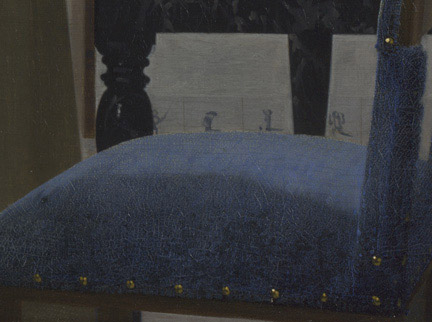
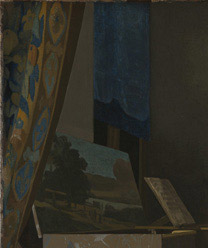
Touches of a bright mid-blue of ultramarine combined with lead white are introduced in the landscape pictures and for the jacket of 'Young Woman standing at a Virginal' [fig.4], and for the cool blue-greys of the tiled floors [fig.5].
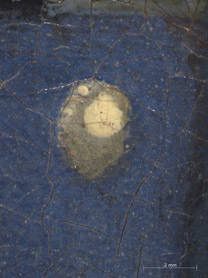
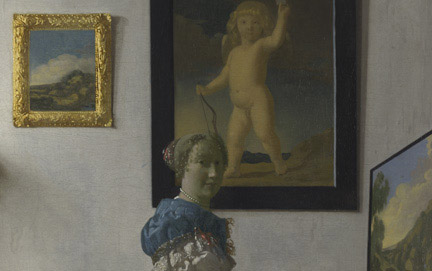
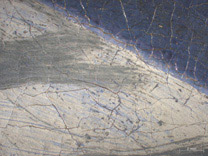
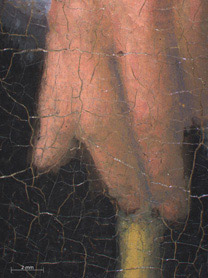
In 'The Music Lesson' ultramarine is used for the shadow in the flesh tones of the male figure [fig.6].2 Ultramarine has also been identified in the cool highlight on the upper edges of the young woman's outstretched arms in the 'Young Woman seated at a Virginal' of about 1670–2, acquired by Baron Rolin in 1960.3
The pigment is combined in mixtures to produce a wide range of other colours: for example ultramarine has been mixed with red lake to form an array of purples in 'The Music Lesson' for the leaded lights, tablecloth pattern, man's sash and for shading the wall on the left [figs.7–9].
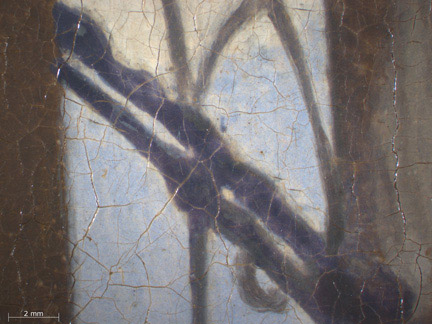
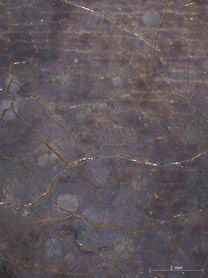
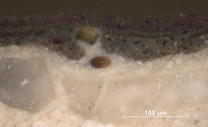
More unusually, ultramarine has been combined with green earth to form a range of blue-greens and greeny-blues. In 'Young Woman seated at a Virginal' the largest area of blue in the painting is her dress, but here ultramarine has been combined with green earth to produce a distinctive blue-green colour [figs.10 & 11].
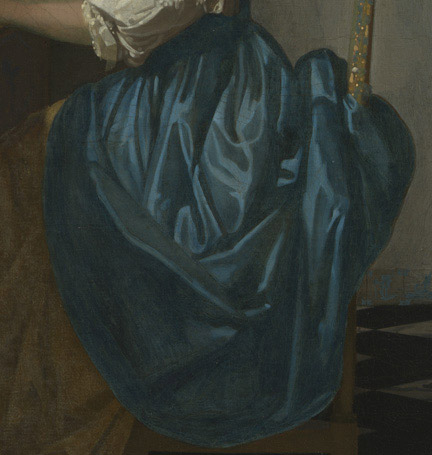
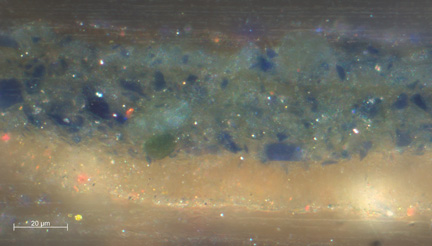
Mixtures of ultramarine and green earth, often applied over an underpaint of green earth combined with black, have also been used for the patterned curtain in this painting [figs.12–14].
What is perhaps most extraordinary is that the costly mineral blue pigment has been used to produce the mixed brown of the ceiling beams in 'The Music Lesson' [figs.15–17], with the likely aim of achieving an integrated colouristic harmony.
The Delft artist Carel Fabritius also used ultramarine for the sky and for the mixed purple/blue of the tablecloth in A View of Delft of 1652, but the pigment was not included in mixed browns or other areas of the painting. Vermeer’s use of ultramarine in this way seems to be exceptional.
Though ultramarine is the only blue pigment employed, evidence from one of the samples from 'Young Woman seated at a Virginal' seems to suggest that the pigment may not always be of high quality. In a paint cross-section from the blue curtain, particles of silica are evident in the upper blue paint layer [figs.18–22].
Since silica is not one of the colourless accessory minerals usually present along with blue lazurite in natural ultramarine, it is possible that the pigment, adulterated with finely ground silica, was purchased unknowingly by Vermeer.4 It is also possible that Vermeer himself sought to extend the expensive natural ultramarine pigment, and, since green earth was used in the underlying layer, it is possible that a little silica-rich green earth, was added to the blue pigment. That Vermeer may have been struggling financially towards the end of his career and thus using poorer quality or adulterated pigment is underscored by his use of old/worn paint brushes (see Secrets of the studio).
The ultramarine-containing paint has often blanched with time resulting in a generally paler colour than it would have been originally in a number of areas, for example in the design of the tiles in 'Young Woman seated at a Virginal' (see Altered appearance of ultramarine), while darkening of the binding medium and additional components present in the paint layers of the curtain and tablecloth in the 'The Guitar Player' make it difficult to be sure whether a dark purple-blue or blue-green colour was originally intended for these fields of colour.
Green earth
Generally prepared from one of two closely related clay minerals, celadonite and glauconite.
Perhaps the most striking feature of the figures in these four paintings is the extensive use of green earth in the depiction of flesh tones [fig.23]. Green earth was frequently employed in the 'Trecento' (the fourteenth century) as an underpaint for flesh. However, what is unusual and characteristic about these late paintings by Vermeer is that green earth is applied over pink and other flesh colours to produce his very distinctive cool shadows.5
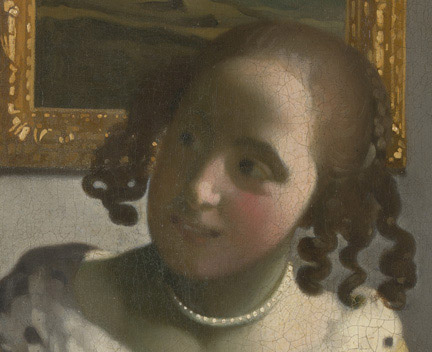
See for example the blocks of pale green shading used for the reflection of the woman’s face in the mirror in 'The Music Lesson' and the extensive use made of green in the flesh of The Guitar Player and 'Young Woman standing at a Virginal' [figs.24–26] including photomicrograph of detail showing green over pink.
Green earth has been identified in works by other 17th-century Dutch artists. Its use as an underpaint in flesh tones by Hendrick ter Brugghen in his Jacob reproaching Laban painted in 1627, is likely to have been prompted by interest in Italian painting practice at that time. However, Vermeer is perhaps unique in his extensive use of the green pigment as a shading over the flesh tones.
Green earth is used extensively elsewhere, to produce a variety of mixed blue/green colours as in the inset landscapes and for the cool light in the window of 'Young Woman standing at a Virginal' [figs.27 & 28] where it is combined with lead-tin yellow.
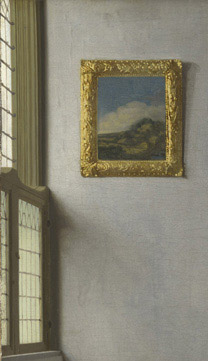
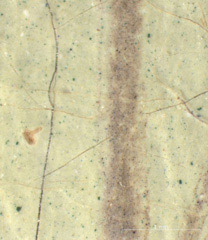
The green earth pigment is of large particle size and very strongly coloured – more strongly coloured than Italian green earth of the 15th and 16th centuries. Green earth was often used in the 17th century and is frequently referred to in contemporary documentary sources. It seems likely that a particularly good quality green earth came on the market at the time. It has been found, for example, in paintings by Salvator Rosa, Claude and others.6
Lead-tin yellow
A traditional manufactured lead pigment which is a binary oxide of lead and tin. In this study the presence of lead-tin yellow was confirmed by SEM/EDX analysis. There are two types of lead-tin yellow and the particle characteristics and conspicuous lack of silicon in samples taken from these paintings suggested the presence of lead-tin yellow type 1. This synthetic yellow pigment was commonly used by Dutch 17th-century painters including Rembrandt and Cuyp7, but disappears from the palettes of artists all over Europe by the early 18th century.
Lead-tin yellow was widely used, as for example, for the yellow jacket in 'The Music Lesson', and in 'The Guitar Player' where it was combined with a yellow lake pigment [figs.29]. Lead-tin yellow was also combined with ultramarine for the shading of the sleeve in 'The Music Lesson' [fig.30]. This yellow pigment frequently shows signs of alteration through the formation of lead soaps (see Formation of lead and zinc soaps).
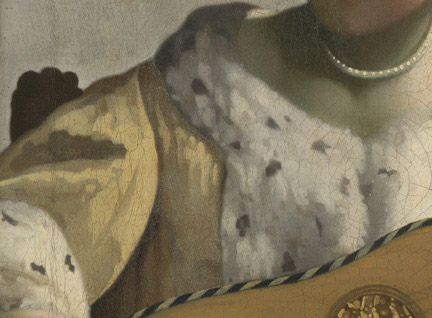
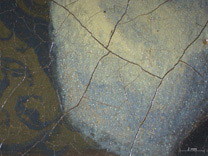
The granular surface in some areas of Vermeer’s paintings has sometimes been interpreted as a deliberate painting technique designed to refract light. It is now clear that, in some cases, the present texture of the surface was not part of the original intention of the artist but is due to an alteration of Vermeer’s painting materials.8 Under magnification the granular effect is shown to be the result of lumpy particles protruding through the paint surface. In some cases, these particles have been identified as soaps, an alteration product caused by chemical interaction between lead (in pigments such as lead-tin yellow and red lead) and the oil binding medium. These particles form beneath the surface and can eventually become so large that they erupt through the upper layers of the painting (see Formation of lead and zinc soaps).
Two different shades of lead-tin yellow (both lead-tin yellow type I) have been identified in 'Young Woman seated at a Virginal' (Private collection, New York), for example in the modelling of the shawl. Similar subtle shades have been noted by Melanie Gifford in 'A Lady Writing', National Gallery of Art, Washington.
Yellow lake
Prepared by the precipitation or adsorption of an organic dyestuff onto an insoluble substrate. A common source for yellow dyestuff was the weld plant. The simplest and most direct method used to extract the dyestuff from the raw material was with water or an alkali. The alkali, or lye, was commonly prepared from the ash of wood or other plants extracted with water. The soluble dyestuff components were then converted into the insoluble lake pigment by the addition of alum (potassium aluminium sulphate) and often in the case of yellow lakes, some form of calcium carbonate such as chalk. In fact, analyses of yellow lakes in 17th-century paintings have shown that they almost always contain predominantly chalk.
In a sample from the yellow sleeve of 'The Guitar Player' lead-tin-yellow has been detected together with a large amount of chalk, most probably employed in the preparation of the yellow lake pigment which has now markedly faded [figs.31–34] (see Fading of yellow and red lake pigments). A single bright yellow particle is visible at the lower left side of the cross-section which was shown by SEM/EDX analysis to be rich in aluminium and sulphur, components also expected to be present in lake pigments. The mid-tone of the drapery laid in first over the ground, and visible in the cross-section as a yellowish translucent layer beneath the pale yellow paint layer, was also found to be rich in chalk, again suggestive of the presence of yellow lake.
Analysis of a sample from the pale yellowish brown skirt in 'Young Woman seated at a Virginal' also suggested the presence of a yellow lake pigment. The paint cross-section shows a pale layer with a particle of bone black (upper left), two tiny particles of red earth and a small yellow particle at lower right. SEM/EDX analysis of this yellow particle indicated the presence of calcium with small amounts of aluminium, sulphur, silica, and phosphorus [figs.35–38]9. The presence of calcium is suggestive of chalk, again indicative of a yellow lake, which has now largely faded.
The paint surface is now rather blanched in appearance and the skirt has a pale yellowish-brown colour, now largely due to overpaint and discoloured varnish. The presence of a little bone black combined with the yellow lake would have made the underskirt skirt originally a slightly greenish-yellow, a colour which would have blended well with the blue/green overskirt.
Vermilion
A red mercuric sulphide pigment prepared from finely ground mineral cinnabar; or artificially prepared by the wet-process or dry-process. Dry process vermilion was extensively manufactured in The Netherlands in the 17th century, while the wet process was not commercialised until the 19th century.
Accents of brilliant red vermilion are applied sparingly in these paintings (except in 'Young Woman seated at a Virginal' where it does not appear to have been used at all) for example: for ribbons, bows ('Young Woman standing at a Virginal' and 'The Music Lesson') [figs.39 & 40]; spine of book and cheek patches in 'The Guitar Player'; and for the skirt [fig.41] and highlights of the tablecloth design in 'The Music Lesson'. The pigment was also used to produce the intense mixed orange colour in the corner of the lid of the virginal in this painting [fig.42].
Red lake
Prepared by the precipitation or adsorption of an organic dyestuff onto an insoluble substrate. The source of the red organic dyestuffs could be plant or animal in origin; dyestuff could be extracted from the roots of the madder plant, for example, or from scale insects such as Mexican cochineal.
A red lake pigment was employed for mixed purples (with natural ultramarine) as previously described [figs.5, 7 & 8]. This pigment was also mixed with lead white for shades of pink, for example in the design on the chair back in 'Young Woman seated at a Virginal' [figs.43 & 44].
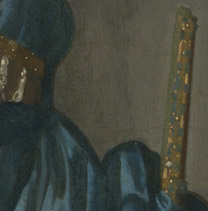
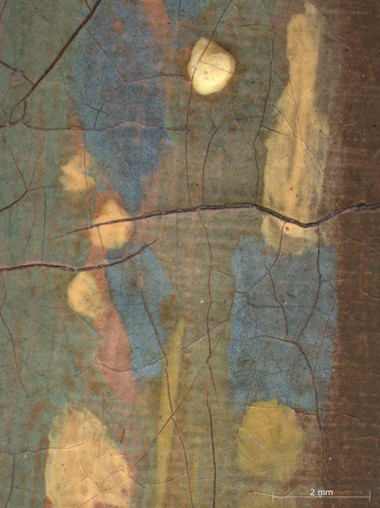
In this painting a sample taken from the warm brown colour of the viol shows multiple layers of red lake pigment combined with calcium carbonate and a very small amount of bone black pigment applied over the ground [figs.45 & 46]. Although a sample for dyestuff analysis could not be obtained, SEM/EDX analysis on the cross-section indicates that the red lake pigment has an alumina substrate10. Given the context and colour of the instrument, it seems likely that the chalk present here is the substrate for a yellow lake which has faded in the uppermost layer.
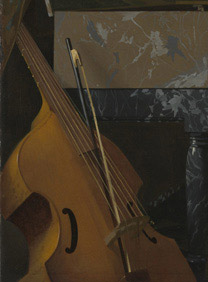
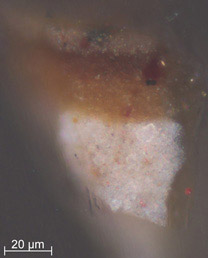
Lead white
The dense, opaque white pigment, basic lead carbonate, has been produced artificially since antiquity.11
From the cross-sections examined, the lead white in these four paintings appears to have a range of particle size consistent with production by the Dutch stack process.12 The pigment is used throughout, in pigment mixtures, applied in impasto and in thin veils of colour [figs.47–50].
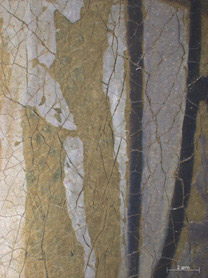
In 'The Art of Painting', Boon and Oberthaler have identified an extremely finely grained lead white pigment employed for the surface layers of the floor tiles. These researchers suggest that this finely divided lead white is the reason for the delamination of some surface paint layers.13 It would be interesting in this respect to investigate the white paint delaminating from within the window leadings in 'The Music Lesson' to see if the surface loss here is due to a similar phenomenon [fig.51]. Unfortunately, it was not possible to take a paint sample from this area. However, visual examination at magnification suggest that there are a number of factors which might be considered in relation to this type of loss: the upper white paint layer may be too lean (poorly bound); the underlying layer was too dry and may have had a surface accretion of dust preventing proper adhesion of the uppermost layer; and eruptions from underlying layers may be implicated in pushing off the fine white surface paint layer in these areas.
Helen Howard is Scientific Officer – Microscopist at the National Gallery. This material was published to coincide with the exhibition Vermeer and Music: The Art of Love and Leisure.
Explore more topics
Original methods and material
- Support and ground
- Infrared examination
- Vermeer's palette
- Binding medium
- Paint application
- Secrets of the studio
Time and transformation
- Altered appearance of ultramarine
- Fading of yellow and red lake pigments
- Drying and paint defects
- Formation of lead and zinc soaps
H. Kühn, 'A Study of the Pigments and the Grounds Used by Jan Vermeer' in 'Report and Studies in the History of Art', Washington 1968, pp. 155–202.
I. Gaskell and M. Jonker, eds., 'Vermeer Studies', New Haven and London 1998.
N. Costaras, 'A Study of the Materials and Techniques of Johannes Vermmer', in I. Gaskell and M. Jonker, eds., 'Vermeer Studies', New Haven and London 1998, pp.145–67.
M. Gifford, 'Painting Light: Recent Observations on Vermeer's Technique', in I. Gaskell and M. Jonker, eds., 'Vermeer Studies', New Haven and London 1998, pp.185–99.
K. Groen, I. Van der Werf, K. Van den Berg and J. Boon, 'Scientific Examination of Vermeer's "Girl with a Pearl Earring"', in I. Gaskell and M. Jonker, eds., 'Vermeer Studies', New Haven and London 1998, pp. 169–83.
J. Wadum, 'Contours of Vermeer', in I. Gaskell and M. Jonker, eds., 'Vermeer Studies', New Haven and London 1998, pp. 201–23.
'Vermeer „Die Malkunst”: Spurensicherung an einem Meisterwerk', exh. cat., Kunsthistorisches Museum, Vienna 2010, pp.235–53 and 328–35.
J. Boon and E. Oberthaler, 'Mechanical Weakness and Chemical Reactivity Observed in the Paint Structure and Surface of "The Art of Painting"' in 'Vermeer „Die Malkunst”: Spurensicherung an einem Meisterwerk', exh. cat., Kunsthistorisches Museum, Vienna 2010, pp.235–53 and 328–35.
E. Oberthaler, J. Boon, S. Stanek and M. Griesser, '"The Art of Painting" by Johannes Vermeer. History of Treatments and Observations on the Present Condition', in 'Vermeer „Die Malkunst”: Spurensicherung an einem Meisterwerk', exh. cat., Kunsthistorisches Museum, Vienna 2010, pp. 215–34 and 322–27, especially illustrations 49 and 50.
L. Sheldon and N. Costaras, 'Johannes Vermeer's "Young Woman Seated at a Virginal"' in 'The Burlington Magazine', vol. 148/February (2006), pp.89–97.
2. The dark shading of the man's face in 'The Music Lesson' is due to a pentimento – he was moved to a more upright position (see Infrared examination).
3. Ultramarine was also used for the grey wall in this picture, see L. Sheldon and N. Costaras, 'Johannes Vermeer's "Young Woman Seated at a Virginal"' in 'The Burlington Magazine', vol. 148/February (2006), p. 94.
4. The identification of silica as a constituent of the original paint layer is of particular interest in relation to the question of texture in Vermeer's paint. It has long been suggested that Vermeer added silica to produce textural effects, as for example in the rooftops in 'View of Delft' (Mauritshuis, The Hague). However in a number of instances it has now been shown that granular texture in the paint is likely to be due to the alteration of original materials, such as in the formation of lead soaps. See E. Reissner, 'Texture, Transparency and Opacity in the Writing of Art History: Approaches to Materiality in the Study of Netherlandish Painting of the Seventeenth Century' in 'Zeitschrift für Kunsttechnologie und Konservierung', vol. 26 (2) (2012), pp. 448–61.
5. Green earth has also been identified in the shading of flesh tones in another painting recently attributed to Vermeer and dated to 1670–2. See, L. Sheldon and N. Costaras, 'Johannes Vermeer's "Young Woman Seated at a Virginal"' in 'The Burlington Magazine', vol. 148/February (2006), pp. 89–97.
6. See for example the intense colour of the green earth pigment in a sample from Salvator Rosa's Landscape with Mercury and the Dishonest Woodman of 1649.
7. See A. Roy and J. Kirby, 'Rembrandt's Palette' in 'Art in the Making: Rembrandt', London 2006, pp. 35–44, especially pp. 38–9. For Cuyp, see M. Spring and L. Keith, 'Aelbert Cuyp’s Large Dort: Colour Change and Conservation' in 'National Gallery Technical Bulletin', vol. 30 (2009), pp. 71–85.
http://www.nationalgallery.org.uk/technical-bulletin/spring_keith2009
Also see H. Kühn, 'Lead-tin Yellow', in A. Roy, ed., 'Artists' Pigments', vol. II, Washington 1993, pp. 83–112 and A. Roy and B. Berry, 'A New Lead-based Yellow in the Seventeenth Century' in A. Roy and P. Smith, eds., 'Painting Techniques, History, Materials and Studio Practice: Contributions to the Dublin Congress 7–11 September 1998', 1998, pp. 160–65.
8. See Reissner footnote 4.
9. This elemental profile was also given by the now pale layer generally. The identification of chalk and alum together agrees well with contemporary documentary sources such as De Mayerne (1622–1644) who says that to manufacture weld, 'the dye should be precipitated first onto alum and then kneaded with chalk'. HPLC analysis suggested the presence of weld in 'The Girl with the Pearl Earring', see K. Groen, I. van der Werf, K. van den Berg and J. Boon, 'Scientific Examination of Vermeer's "Girl with a Pearl Earring"' in I. Gaskell and M. Jonker, eds., 'Vermeer Studies' , New Haven and London 1998, pp. 169–83, see especially, pp. 173–4. Yellow lake glazes have also been found in 'The Art of Painting', for example in the chandelier and buttons of the chair, see E. Oberthaler, J. Boon, S. Stanek and M. Griesser, '"The Art of Painting" by Johannes Vermeer. History of Treatments and Observations on the Present Condition' in 'Vermeer "Die Malkunst": Spurensicherung an einem Meisterwerk', exh. cat., Kunshistorisches Museum, Vienna 2010, pp. 215–33 and 322–27, especially illustrations 49 and 50, p. 243.
10. A red lake pigment, likely to be cochineal on an alumina substrate, has been identified as a component of the original varnish of 17th and 18th century Stradivari violins, see J.-P. Echard, 'The Nature of the Extraordinary Finish of Stradivari's Instruments' in 'Angewandte Chemie International Edition', vol. 49/1 (2010), pp. 197–201.
11. See M. Stols-Witlox, '"The Heaviest and the Whitest": Lead White Quality in North Western European Documentary Sources, 1400-1900', in M. Spring ed., 'Studying Old Master Paintings: Technology and Practice. The National Gallery Technical Bulletin 30th Anniversary Conference Postprints', 2011, pp. 284-294
12. The 'Dutch' or 'stack' process differs little in principle from the process of manufacture used in the medieval period, where strips of metallic lead were exposed to acetic acid (usually in the form of a dilute solution of vinegar) in a warm, carbon dioxide-rich environment for several months. See R. J. Gettens, H. Kühn and W. T. Chase, 'Lead White' in A. Roy, ed., 'Artists' Pigments: A Handbook of their History and Characteristics', vol. 2, Oxford 1993, pp. 67–81.
13. See J. Boon and E. Oberthaler, 'Mechanical Weakness and Chemical Reactivity Observed in the Paint Structure and Surface of "The Art of Painting"' in 'Vermeer „Die Malkunst“: Spurensicherung an einem Meisterwerk', exh. cat., Kunshistorisches Museum, Vienna 2010, pp. 235–53; and Oberthaler et al., '"The Art of Painting" by Vermeer: History of Treatments and Observations on the Present Condition', as above 2010, pp. 215–34, see especially, p. 225, fig. 33.

